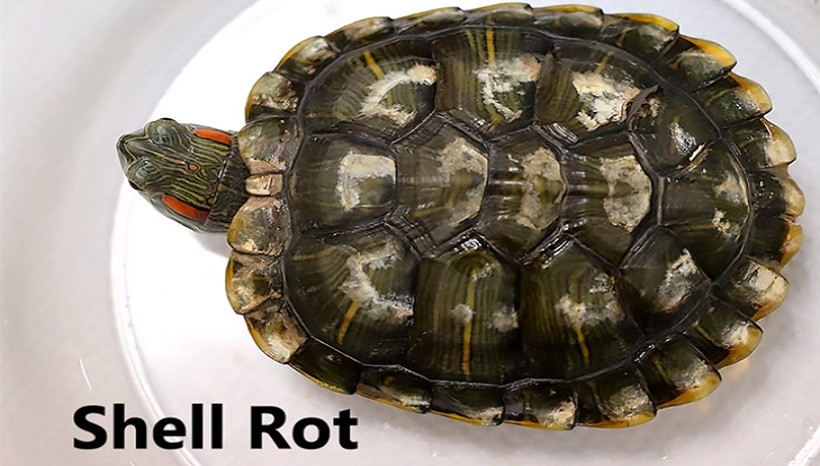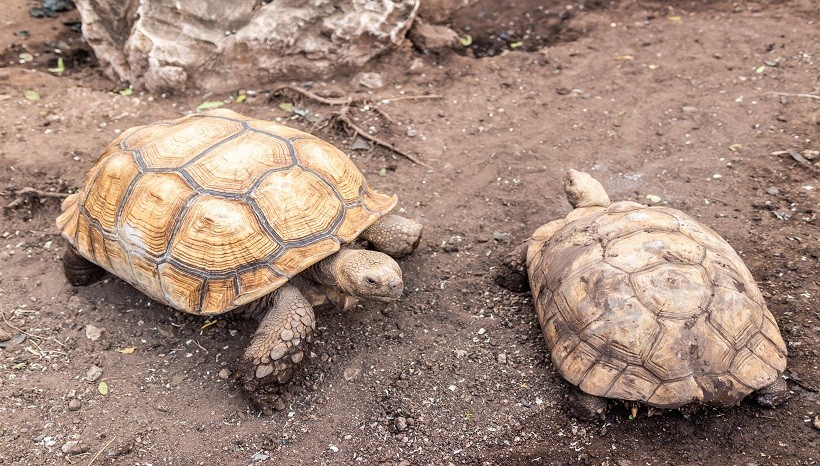Strange white spots are sometimes spotted on the carapace of the turtle, the shell’s upper part. It is a familiar problem in turtles, painless to treat. The study has found out that three possible reasons can lead to these white spots formation. These include a deposit of minerals, shell rot or its possibility, and skin and scutes of the turtle start shedding.
These particular spots indicate one of the abnormalities that the turtle is facing. These spots aren’t very dangerous and there is nothing to worry about. They are easy to settle. These white spots shape themselves in two ways. They can appear in the form of large circle kind of spots on the shell or can shape themselves up in the form of small patches. Mostly they are found on the neck or legs of the turtle.
Why Does My Turtle Have White Spots On Its Shell?
Turtles have white spots on their shell due to various causes. Let’s look at these different reasons for certain spots on the body.
-
Mineral Deposits
The first reason is referred to as mineral deposits which transform a large area on the shell of a turtle into white spots. There might be a chance that hard water is present around the turtle’s habitat or the turtle spends his time in hard water. Hard water contains huge deposits of Magnesium and Calcium Carbonate.
Although this is not dangerous for turtles and will not cause any harm, it still looks odd on a turtle’s shell. But be careful, it is important to check the health of the turtle when the turtle possesses white spots on the outer layer of the shell. If his health is alright, then it is due to the deposit of minerals.
Calcium Carbonate in hard water dries up on the body of the turtle and hence these spots are made. When the turtle becomes dry, clean and disinfect the shell well. Make a mixture of vinegar with water and apply it to the affected areas of the shell. Within a week, these spots will be removed.
-
Shell Rot
Shell rot takes place due to an infection on the shell, possibly some kind of bacterial infection, or fungal infection. Although shell rot can be easily dealt with and is not harmful if treated properly. If it is not treated properly, a turtle’s health can worsen and often leads to death.
If white spots show an uneven pattern and tiny pits are also forming along with them, then it is shell rot. Shell rot ointment is available, and applying regularly will make a turtle recover within three weeks.
Scute And Skin Shedding
This shedding is common in aquatic turtles. Dysecdysis and Ecdysis and two types of shedding, abnormal and normal shedding respectively. Both can be due to different causes. Scute shedding is a natural process that results in the growth of the turtle’s shell. To ensure that these spots don’t remain for a long time on the turtle’s shell, just keep the turtle in Ultra-Violet B (UVB) light and you will see instant recovery.
Red-eared Slider Shell Turning White

Red-eared slider shells can develop white and dull gray spots or small patches in the sides and top of their shell. These are a result of some fungal growth. Researchers have found out that this fungal growth can occur due to two possible reasons.
Firstly, the poor water quality. The unhygienic water around their habitat or where red-eared slider turtles spend most of their time. Secondly, the lack of a proper basking area. Good and warm heat from ultraviolet B (UVB) light is what the turtle needs in this situation. The heat from UVB light can be good in curing white spots in red-eared slider turtles.
Turtle Shell Turning White
Well, in this case, there must be a check because it can sometimes be normal or abnormal, too. If a turtle is eating healthy, basking, and behaving normally instead of behaving abnormally, then it is natural. It happens when turtles grow with their age, their genetics changes and for the sole reason, their shell changes its color, and their skin also shows the change in their color.
If it is not natural, like the above factors are not coinciding with it, then it is recommended to give the turtle a vet check-up because it must be found out whether due to their age or turtle is suffering through any disease or respiratory infection.
Turtle Skin Fungus

Turtles can develop skin fungus due to improper inhabitants and surrounding areas where they stay for most of their time. Aquatic turtles are most vulnerable to land turtles against suffering through this fungus. Although, it can be treated and the turtle can be cured if treated properly on time. It can turn fatal if left unattended.
Possible symptoms can be blisters, peeling of skin or shell, and the presence of a strange substance on the skin which looks like cheese. Skin shedding is normal and can’t lead to a lethal fungal infection. Skin shedding won’t lead to any rough white spots on the turtle’s shell, nor any kind of swelling on the turtle’s body nor will it create red spots on the skin. It is due to poor quality of the water or improper turtle basking area. Their treatment is possible and it must be treated before it is too late.
Dry Turtle Shell
If a turtle shell changes its appearance and looks dull and dry, nothing to worry about. It occurs due to mineral deposits, scutes, and rapid fluctuation in humidity levels.
Hard water carries a huge amount of Magnesium and Calcium Carbonate. When a turtle sits in this water and then comes out of the water to soak himself, obviously water won’t quickly be swept out of its shell. It will take some time. After soaking, water will be gone but Calcium Carbonate will be left on its shell. This makes the turtle’s shell dry and hard. Cleaning the shell with water mixed with vinegar will make it go back to normal within a week or two.
Another reason is the growth of turtles results in underneath scutes taking the place of outer scutes. Dry shell is due to retained scutes. This isn’t a big issue. Give your turtle warmth of UVB light and keep the basking area of the turtle dry.
The last reason could be the humidity level. It could mostly happen to semi-aquatic turtle species. Simply, change the habitat and living environment of the turtle. Give some new breathing space to the turtle. As soon as the turtle will adapt to this new environment, everything will become normal.
Conclusion
White spots are somewhat natural on a turtle’s shell and sometimes it is due to an infection, like a fungal infection. Apart from fungal infection, nothing is lethal. If fungal infection is handled with care and treated on time, everything stands normal. Possible reasons are hard water and rotting of shell apart from fungal infection.
A takeaway from this discussion is that an inadequate living environment should be avoided for turtles, keep their basking areas neat and clear and if possible, keep them a little warm. UVB light goes well in providing nice heat to the specific area. Treatment of everything is available and if handled properly, everything is in your control. Also, if a turtle is affected by a fungal infection, his diet plays a vital role in recovering him.
If you want to learn more about pets visit us at petshoods
{ "@context": "https://schema.org", "@type": "Article", "mainEntityOfPage": { "@type": "WebPage", "@id": "https://petshoods.com/white-spots-on-turtle-shell/" }, "headline": "White Spots On Turtle Shell | Why Does Its Shell Turn White?", "description": "White Spots On Turtle Shell Is A Common And Temporary Problem. It May Occur When A Turtle Is About To Shed Its Scutes, Uneven Mineral Deposits, Or Shell Rot.", "image": "https://petshoods.com/wp-content/uploads/2021/08/White-Spots-On-Turtle-Shell-768x436.jpg", "author": { "@type": "Person", "name": "Jeremy" }, "publisher": { "@type": "Organization", "name": "Petshoods", "logo": { "@type": "ImageObject", "url": "https://petshoods.com/wp-content/uploads/2019/02/13925402_1502331219793083_1620090286454245017_n.jpg" } }, "datePublished": "2021-08-25", "dateModified": "2021-09-18" }